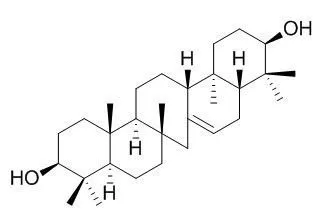| In vitro: |
| Cancer Lett. 2003 Jul 10;196(2):121-6. | | Cancer chemopreventive activity of serratane-type triterpenoids on two-stage mouse skin carcinogenesis.[Pubmed: 12860269] |
METHODS AND RESULTS:
Eleven serratane-type triterpenoids isolated from the stem bark of Picea jezoensis (Sieb. et Zucc.) Carr. var. jezoensis (Pinaceae) and the stem bark of Picea jezoensis (Sieb. et Zucc.) Carr. var. hondoensis (Mayer) Rehder (Pinaceae) and three synthetic analogs were studied for their possible inhibitory effects on Epstein-Barr virus early antigen (EBV-EA) activation induced by 12-O-tetradecanoylphorbol-13-acetate (TPA). 21-Episerratenediol, serratenediol, diepiserratenediol, 3 beta-hydroxyserrat-14-en-21-one, 3 alpha-methoxy-21 beta-hydroxyserrat-14-en-16-one, 3 beta-methoxyserrat-14-en-21 beta-yl acetate, 3 alpha-methoxyserrat-14-en-21 beta-yl acetate and 3 beta-methoxyserrat-14-en-21 alpha-yl acetate demonstrated strong inhibitory effects on the EBV-EA activation without showing any cytotoxicity, their effects being stronger than that of a representative control, oleanolic acid. Furthermore, 21-Episerratenediol exhibited a remarkable inhibitory effect on skin tumor promotion in an in vivo two-stage mouse skin carcinogenesis test using 7,12-dimethylbenz[a]anthracene as an initiator and TPA as a promoter.
CONCLUSIONS:
The result of the present investigation indicated that 21-Episerratenediol might be valuable as a potent cancer chemopreventive agent. | | Cancer Lett. 2004 Oct 28;214(2):149-56. | | Cancer chemopreventive activity of 3beta-methoxyserrat-14-en-21beta-ol and several serratane analogs on two-stage mouse skin carcinogenesis.[Pubmed: 15363540] | 3beta-Methoxyserrat-14-en-21beta-ol (1) and 3alpha-methoxyserrat-14-en-21beta-ol (2) are the most abundant triterpenoids from two Picea plants, Picea jezoensis (Sieb. et Zucc.) Carr. var. jezoensis and P. jezoensis (Sieb. et Zucc.) Carr. hondoensis (Mayr) Rehder, and the total yield of 1 and 2 reach over 1/3 of the chloroform extract of the above two plants.
METHODS AND RESULTS:
This study deals with the potential of anti-tumor promoting activity of 1 and results of the assay of 22 synthetic serratane-type triterpenoids (6)-(27) derived from 1, 2, 21-Episerratenediol (3), diepiserratenediol (4) and 13alpha,14alpha-epoxy-3beta-methoxyserratan-21beta-ol (5) to discuss the structure-activity relationship. As a preliminary evaluation of their potential to inhibit tumor promotion, the inhibitory effects on Epstein-Barr virus early antigen (EBV-EA) activation induced by 12-O-tetradecanoylphorbol-13-acetate (TPA) were used. All compounds except for 12 and 19 showed potent inhibitory effects on EBV-EA induction (100% inhibition at 1000 mol ratio/TPA), their effects being stronger than that of a positive control oleanolic acid. Compounds 1, 13, 14, 18, 20 and 26 were selected to examine the effect on the in vivo two-stage mouse skin carcinogenesis test induced by 7,12-dimethylbenz[a]anthracene (DMBA) as an initiator and TPA as a promoter.
CONCLUSIONS:
The most abundant triterpenoid 1 and the synthetic compounds 13 and 14 were found to exhibit the excellent anti-tumor promoting activity in the in vivo carcinogenesis test, and compounds 18, 20 and 26 also showed strong inhibitory effects. |
|






 Cell. 2018 Jan 11;172(1-2):249-261.e12. doi: 10.1016/j.cell.2017.12.019.IF=36.216(2019)
Cell. 2018 Jan 11;172(1-2):249-261.e12. doi: 10.1016/j.cell.2017.12.019.IF=36.216(2019) Cell Metab. 2020 Mar 3;31(3):534-548.e5. doi: 10.1016/j.cmet.2020.01.002.IF=22.415(2019)
Cell Metab. 2020 Mar 3;31(3):534-548.e5. doi: 10.1016/j.cmet.2020.01.002.IF=22.415(2019) Mol Cell. 2017 Nov 16;68(4):673-685.e6. doi: 10.1016/j.molcel.2017.10.022.IF=14.548(2019)
Mol Cell. 2017 Nov 16;68(4):673-685.e6. doi: 10.1016/j.molcel.2017.10.022.IF=14.548(2019)